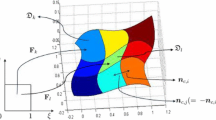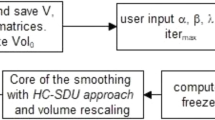Abstract
Intersections and discontinuities commonly arise in surface modeling and cause problems in downstream operations. Local geometry repair, such as cover holes or replace bad surfaces by adding new surface patches for dealing with inconsistencies among the confluent region, where multiple surfaces meet, is a common technique used in CAD model repair and reverse engineering. However, local geometry repair destroys the topology of original CAD model and increases the number of surface patches needed for freeform surface shape modeling. Consequently, a topology recovery technique dealing with complex freeform surface model after local geometry repair is proposed. Firstly, construct the curve network which determine the geometry and topology properties of recovery freeform surface model; secondly, apply freeform surface fitting method to create B-spline surface patches to recover the topology of trimmed ones. Corresponding to the two levels of enforcing boundary conditions on a B-spline surface, two solution schemes are presented respectively. In the first solution scheme, non-constrained B-spline surface fitting method is utilized to piecewise recover trimmed confluent surface patches and then employs global beautification technique to smoothly stitch the recovery surface patches. In the other solution scheme, constrained B-spline surface fitting technique based on discretization of boundary conditions is directly applied to recover topology of surface model after local geometry repair while achieving G 1 continuity simultaneously. The presented two different schemes are applied to the consistent surface model, which consists of five trimmed confluent surface patches and a local consistent surface patch, and a machine cover model, respectively. The application results show that our topology recovery technique meets shape-preserving and G 1 continuity requirements in reverse engineering. This research converts the problem of topology recovery for consistent surface model to the problem of constructing G 1 patches from a given curve network, and provides a new idea to model repairing study.
Similar content being viewed by others
References
HAMANN B, JEAN B A. Interactive surface correction based on a local approximation scheme[J]. Computer Aided Geometric Design, 1996, 13(4): 351–368.
KE Yinglin, FAN Shuqian. Local consistent mending technique for complex surfaces[J]. Journal of Computer-Aided Design & Computer Graphics, 2005, 17(3): 418–424. (in Chinese)
JIA Ming, LU Zhen, LI Yongqing, et al. Local coincided design based on trimmed B-spline surfaces[J]. Chinese Journal of Mechanical Engineering, 2003, 39(2): 74–78. (in Chinese)
BIAN Keke, WANG Qing, LI Jiangxiong, et al. Local consistent mending technique for complex freeform surface model[J]. Journal of Zhejiang University (Engineering Science). 2009, 43(6): 1 118–1 123. (in Chinese)
GELSTON M S, DEBASISH D. Boundary surface recovery from skeleton curves and surfaces[J]. Computer Aided Geometric Design, 1995, 12(1): 27–51.
MILROY M J, BRADLEY C, VICKERS G W. Segmentation of a wrap-around model using an active contour[J]. Computer-Aided Design, 1997, 29(4): 299–320.
KRISHNAMURTHY V, LEVOY M. Fitting smooth surfaces to dense polygon meshes[C]//Proceedings of SIGGRAPH 96, 4–9 August, 1996, New Orleans, Louisiana, USA. ACM SIGGRAPH, 1996: 313–324
VARADY T, MARTIN R R, COX J. Reverse engineering of geometric models — an introduction[J]. Computer-Aided Design, 1997, 29(4): 255–268.
CHO D Y, LEE K Y, KIM T W. Interpolating G 1 Bézier surfaces over irregular curve networks for ship hull design[J]. Computer-Aided Design, 2006, 38(6): 641–660.
LIN Hongwei, CHEN Wei, BAO Hujun. Adaptive patch-based mesh fitting for reverse engineering[J]. Computer-Aided Design, 2007, 39: 1 134–1 142.
MILROY M J, BRADLEY C, VICKERS G W, et al. G 1 continuity of B-spline surface patches in reverse engineering[J]. Computer-Aided Design, 1995, 27(6): 471–478.
ECK M, HOPPE H. Automatic reconstruction of B-spline surfaces of arbitrary topological type[C]//Proceedings of SIGGRAPH 96, 4–9 August, 1996, New Orleans, Louisiana, USA. ACM SIGGRAPH, 1996: 325–334.
SHI Xiquan, WANG Tianjun, YU Piqiang. A practical construction of G 1 smooth biquintic B-spline surfaces over arbitrary topology[J]. Computer-Aided Design, 2004, 36(5): 413–424.
SHI Xiquan, WANG Tianjun, YU Piqiang, et al. Reconstruction of convergent G 1 smooth B-spline surfaces[J]. Computer Aided Geometric Design, 2004, 21: 893–913.
SARRAGA R. G 1 interpolation of generally unrestricted cubic Bézier curves[J]. Computer Aided Geometric Design, 1987, 4(1–2): 23–40.
PETER J. Biquartic C1-surface splines over irregular meshes[J]. Computer-Aided Design, 1995, 27(12): 895–903.
YE X, NOWACKI H. G 1 interpolation of rectangular cubic curve meshes using biquintic Bézier patches[C]//The Sixth IMA Conference on the Mathematics of Surfaces, September, 1994, Brunel University, UK. Oxford University Press, 1996: 429–452.
MA Lizhuang, PENG Qunsheng. Smoothing of free-form surfaces with Bézier patches[J]. Computer Aided Geometric Design, 1995, 12(3): 231–249.
KRUTH J P, KERSTENS A. Reverse engineering modeling of free-form surface from point clouds subject to boundary conditions[J]. Journal of Material Processing Technology, 1998, 76(1–3): 120–127.
MA Y L, HEWITT W T. Point inversion and projection for NURBS curve and surface: Control polygon approach[J]. Computer Aided Geometric Design, 2003, 20(2): 79–99.
PEGNA J, WOLTER F E. Surface curve design by orthogonal projection of space curves onto free-form surfaces[J]. Journal of Mechanical Design, 1996, 118(1): 45–52.
PIEGL L, TILLER W. The NURBS book[M]. 2nd ed. New York: Springer-Verlag, 1997.
HU S M, TAI C L, ZHANG S H. An extension algorithm for B-splines by curve unclamping[J]. Computer-Aided Design, 2002, 34(5): 415–419.
TAI C L, HU S M, HUANG Q X. Approximate merging of B-spline curves via knot adjustment and constrained optimization[J]. Computer-Aided Design, 2003, 35(10): 893–899.
PIEGL L A, TILLER W. Parametrization for surface fitting in reverse engineering[J]. Computer-Aided Design, 2001, 33(8): 593–603.
MA W Y, KRUTH J P. Parameterization of randomly measured points for least squares fitting of B-spline curves and surfaces[J]. Computer -Aided Design, 1995, 27(9): 663–675.
CHEN Xi. Study on feature mining technology based on point cloud in reverse engineering[D]. Hangzhou: Zhejiang University, 2005. (in Chinese)
BIAN Keke, LI Jiangxiong, KE Yinglin. Topology recovery technique for complex freeform surface model based on local consistent mending[J]. Journal of Mechanical Engineering, 2009, 45(7): 16–22. (in Chinese)
WEISS V, ANDOR L, RENNER G, et al. Advanced surface fitting techniques[J]. Computer Aided Geometric Design, 2002, 19(1): 19–42.
HOLLIG K, REIF U. Nonuniform web splines[J]. Computer Aided Geometric Design, 2003, 20(5): 277–294.
FAN Shuqian. Beautification technique for freeform models in reverse engineering[D]. Hangzhou: Zhejiang University, 2006. (in Chinese)
KIMURA M, SAITO T, SHINYA M. Surface deformation with differential geometric structures[J]. Computer Aided Geometric Design, 1996, 13(3): 243–256.
WELCH W, WITKIN A. Variational surface modeling[J]. Computer Graphics, 1992, 26(2): 157–165.
BIAN Keke. Research on continuity adjustment and topology recovery technique for complex freeform surface in reverse engineering[D]. Hangzhou: Zhejiang University, 2010. (in Chinese)
Author information
Authors and Affiliations
Corresponding author
Additional information
This project is supported by China Postdoctoral Science Foundation (Grant No. 20110490376), and National Natural Science Foundation of China (Grant No. 50575098)
BIAN Keke, born in 1982, is currently a postdoctoral researcher at Department of Precision Instruments and Mechanology, Tsinghua University, China. He received his PhD degree from Zhejiang University, China, in 2010. His research interests include reverse engineering, CAD and CAGD.
KE Yinglin, born in 1963, is currently a professor and a PhD candidate supervisor at Zhejiang University, China. His research interests include reverse engineering, CAD/CAE/CAM, physics-based simulation of machining process, and special technology equipment design.
Rights and permissions
About this article
Cite this article
Bian, K., Ke, Y. Topology recovery technique for complex freeform surface model after local geometry repair. Chin. J. Mech. Eng. 26, 197–206 (2013). https://doi.org/10.3901/CJME.2013.01.197
Received:
Revised:
Accepted:
Published:
Issue Date:
DOI: https://doi.org/10.3901/CJME.2013.01.197




